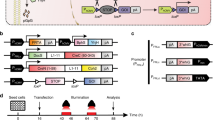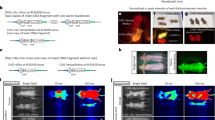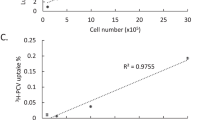Abstract
Site-specific recombination tools such as the Cre–loxP system are used to create animal models where conditional gene deletion/activation studies are required. In the current proof of principle study, we have demonstrated that a PET reporter gene (PRG), the herpes simplex virus type 1 thymidine kinase (HSV1-tk), can be made to remain silent and can be activated by Cre–loxP-mediated recombination in cell culture and in living mice. An adenovirus carrying a silent HSV1-tk was tail-vein injected (1x109 PFU) in six transgenic mice that express Cre recombinase in their liver (Cre+) and in four control mice (Cre−). The liver-specific expression of the PRG in Cre+ mice was detected in the microPET following injection of the reporter probe, 9-[4-fluoro-3-(hydroxymethyl)butyl]guanine ([18F]-FHBG). The [18F]-FHBG accumulation in the liver in terms of percent-injected dose per gram of tissue was 7.72±1.13 for the Cre+ mice and 0.10±0.02 for the Cre− mice (P<0.05) 48 h after adenoviral injection. These results were further validated by quantitative RT-PCR, western blotting and by in vitro assays for herpes simplex virus type 1 thymidine kinase enzyme activity. Thus by using the Cre–loxP system it is possible to modulate a PRG and noninvasively monitor the extent of Cre–loxP-mediated gene activation by imaging in a microPET scanner.
This is a preview of subscription content, access via your institution
Access options
Subscribe to this journal
Receive 12 print issues and online access
$259.00 per year
only $21.58 per issue
Buy this article
- Purchase on Springer Link
- Instant access to full article PDF
Prices may be subject to local taxes which are calculated during checkout




Similar content being viewed by others
References
Grainge I, Jayaram M . The integrase family of recombinase: organization and function of the active site. Mol Microbiol 1999; 33: 449–456.
Voziyanov Y, Pathania S, Jayaram M . A general model for site-specific recombination by the integrase family recombinases. Nucleic Acids Res 1999; 27: 930–941.
Hoess RH, Ziese M, Sternberg N . P1 site-specific recombination: nucleotide sequence of the recombining sites. Proc Natl Acad Sci USA 1982; 79: 3398–3402.
Guo F, Gopaul DN, Van Duyne GD . Asymmetric DNA bending in the Cre–loxP site-specific recombination synapse. Proc Natl Acad Sci USA 1999; 96: 7143–7148.
Lakso M et al. Targeted oncogene activation by site-specific recombination in transgenic mice. Proc Natl Acad Sci USA 1992; 89: 6232–6236.
Sauer B . Manipulation of transgenes by site-specific recombination: use of Cre recombinase. Methods Enzymol 1993; 225: 890–900.
Groszer M et al. Negative regulation of neural stem/progenitor cell proliferation by the Pten tumor suppressor gene in vivo. Science 2001; 294: 2186–2189.
Lesche R et al. Cre/loxP-mediated inactivation of the murine Pten tumor suppressor gene. Genesis 2002; 32: 148–149.
Di Cristofano A, Pesce B, Cordon-Cardo C, Pandolfi PP . Pten is essential for embryonic development and tumour suppression. Nat Genet 1998; 19: 348–355.
Zhuo L et al. hGFAP-cre transgenic mice for manipulation of glial and neuronal function in vivo. Genesis 2001; 31: 85–94.
Akagi K et al. Cre-mediated somatic site-specific recombination in mice. Nucleic Acids Res 1997; 25: 1766–1773.
Stec DE et al. Efficient liver-specific deletion of a floxed human angiotensinogen transgene by adenoviral delivery of Cre recombinase in vivo. J Biol Chem 1999; 274: 21285–21290.
Kawamoto S et al. A novel reporter mouse strain that expresses enhanced green fluorescent protein upon Cre-mediated recombination. FEBS Lett 2000; 470: 263–268.
Gambhir SS et al. Imaging transgene expression with radionuclide imaging technologies. Neoplasia 2000; 2: 118–138.
Iyer M et al. 8-[18F]fluoropenciclovir: an improved reporter probe for imaging HSV1-tk reporter gene expression in vivo using PET. [Comment in: J Nucl. Med. 2001 Jan;42(1):106-9 UI: 21038008]. J Nucl Med 2001; 42: 96–105.
Tjuvajev JG et al. Comparison of radiolabeled nucleoside probes (FIAU, FHBG, and FHPG) for PET imaging of HSV1-tk gene expression. J Nucl Med 2002; 43: 1072–1083.
Nagayama Y et al. Enhanced efficacy of transcriptionally targeted suicide gene/prodrug therapy for thyroid carcinoma with the Cre–loxP system. Cancer Res 1999; 59: 3049–3052.
Wagner KU et al. Cre-mediated gene deletion in the mammary gland. Nucleic Acids Res 1997; 25: 4323–4330.
Anton M, Graham FL . Site-specific recombination mediated by an adenovirus vector expressing the Cre recombinase protein: a molecular switch for control of gene expression. J Virol 1995; 69: 4600–4606.
Wu JC, Sundaresan G, Iyer M, Gambhir SS . Noninvasive optical imaging of firefly luciferase reporter gene expression in skeletal muscles of living mice. Mol Ther 2001; 4: 297–306.
Contag CH et al. Photonic detection of bacterial pathogens in living hosts. Mol Microbiol 1995; 18: 593–603.
Tripathy SK, Black HB, Goldwasser E, Leiden JM . Immune responses to transgene-encoded proteins limit the stability of gene expression after injection of replication-defective adenovirus vectors. Nat Med 1996; 2: 545–550.
Yang Y et al. Cellular immunity to viral antigens limits E1-deleted adenoviruses for gene therapy. Proc Natl Acad Sci USA 1994; 91: 4407–4411.
Loser P, Jennings GS, Strauss M, Sandig V . Reactivation of the previously silenced cytomegalovirus major immediate-early promoter in the mouse liver: involvement of NFkappaB. J Virol 1998; 72: 180–190.
Liang Q et al. Monitoring adenoviral DNA delivery, using a mutant herpes simplex virus type 1 thymidine kinase gene as a PET reporter gene. Gene Therapy 2002; 9: 1659–1666.
Southgate TD et al. Long-term transgene expression within the anterior pituitary gland in situ: impact on circulating hormone levels, cellular and antibody-mediated immune responses. Endocrinology 2001; 142: 464–476.
Kiwaki K et al. Correction of ornithine transcarbamylase deficiency in adult spf(ash) mice and in OTC-deficient human hepatocytes with recombinant adenoviruses bearing the CAG promoter. Hum Gene Ther 1996; 7: 821–830.
Sakai Y et al. Gene therapy for hepatocellular carcinoma using two recombinant adenovirus vectors with alpha-fetoprotein promoter and Cre/lox P system. J Virol Methods 2001; 92: 5–17.
Goto H et al. Gene therapy utilizing the Cre/loxP system selectively suppresses tumor growth of disseminated carcinoembryonic antigen-producing cancer cells. Int J Cancer 2001; 94: 414–419.
Kijima T et al. Application of the Cre recombinase/loxP system further enhances antitumor effects in cell type-specific gene therapy against carcinoembryonic antigen-producing cancer. Cancer Res 1999; 59: 4906–4911.
Kanegae Y et al. Efficient gene activation system on mammalian cell chromosomes using recombinant adenovirus producing Cre recombinase. Gene 1996; 181: 207–212.
Kanegae Y et al. Efficient gene activation in mammalian cells by using recombinant adenovirus expressing site-specific Cre recombinase. Nucleic Acids Res 1995; 23: 3816–3821.
Niwa H, Yamamura K, Miyazaki J . Efficient selection for high-expression transfectants with a novel eukaryotic vector. Gene 1991; 108: 193–199.
Xu L et al. CMV-beta-actin promoter directs higher expression from an adeno-associated viral vector in the liver than the cytomegalovirus or elongation factor 1 alpha promoter and results in therapeutic levels of human factor X in mice. Hum Gene Ther 2001; 12: 563–573.
Gambhir SS et al. Imaging adenoviral-directed reporter gene expression in living animals with positron emission tomography. Proc Natl Acad Sci USA 1999; 96: 2333–2338.
Kaczmarczyk SJ, Green JE . A single vector containing modified cre recombinase and LOX recombination sequences for inducible tissue-specific amplification of gene expression. Nucleic Acids Res 2001; 29: E56–56.
Iyer M, Berenji M, Templeton NS, Gambhir SS . Noninvasive imaging of cationic lipid-mediated delivery of optical and PET reporter genes in living mice. Mol Ther 2002; 6: 555–562.
Hildebrandt IJ, Iyer M, Wagner E, Gambhir SS . Optical imaging of transferrin targeted PEI/DNA complexes in living subjects. Gene Therapy 2003; 10: 758–764.
Kim J et al. Targeting adenoviral vectors by using the extracellular domain of the coxsackie-adenovirus receptor: improved potency via trimerization. J Virol 2002; 76: 1892–1903.
Nettelbeck DM et al. Targeting of adenovirus to endothelial cells by a bispecific single-chain diabody directed against the adenovirus fiber knob domain and human endoglin (CD105). Mol Ther 2001; 3: 882–891.
Smith JS et al. Redirected infection of directly biotinylated recombinant adenovirus vectors through cell surface receptors and antigens. Proc Natl Acad Sci USA 1999; 96: 8855–8860.
Iyer M et al. Comparison of FPCV, FHBG, and FIAU as reporter probes for imaging Herpes Simplex Virus Type 1 thymidine kinase reporter gene expression. J Nucl Med 2000; 41: 80P–81P.
Bhaumik S, Gambhir SS . Simultaneous imaging of the expression of two bioluminescent reporter genes in living mice. Mol Ther 2002; 5: S422.
Ray P, Wu AM, Gambhir SS . Optical bioluminescence and positron emission tomography imaging of a novel fusion reporter gene in tumor xenografts of living mice. Cancer Res 2003; 63: 1160–1165.
Sadowski I, Ma J, Triezenberg S, Ptashne M . GAL4-VP16 is an unusually potent transcriptional activator. Nature 1988; 335: 563–564.
Emami KH, Carey M . A synergistic increase in potency of a multimerized VP16 transcriptional activation domain. EMBO J 1992; 11: 5005–5012.
Iyer M et al. Two-step transcriptional amplification as a method for imaging reporter gene expression using weak promoters. Proc Natl Acad Sci USA 2001; 98: 14595–14600.
Zhang L et al. Molecular engineering of a two-step transcription amplification (TSTA) system for transgene delivery in prostate cancer. Mol Ther 2002; 5: 223–232.
Braselmann S, Graninger P, Busslinger M . A selective transcriptional induction system for mammalian cells based on Gal4-estrogen receptor fusion proteins. Proc Natl Acad Sci USA 1993; 90: 1657–1661.
Koster RW, Fraser SE . Tracing transgene expression in living zebrafish embryos. Dev Biol 2001; 233: 329–346.
Loonstra A et al. Growth inhibition and DNA damage induced by Cre recombinase in mammalian cells. Proc Natl Acad Sci USA 2001; 98: 9209–9214.
Miyake S et al. Efficient generation of recombinant adenoviruses using adenovirus DNA-terminal protein complex and a cosmid bearing the full-length virus genome. Proc Natl Acad Sci USA 1996; 93: 1320–1324.
Rosenfeld MA et al. Adenovirus-mediated transfer of a recombinant alpha 1-antitrypsin gene to the lung epithelium in vivo. Science 1991; 252: 431–434.
Kolls J, Peppel K, Silva M, Beutler B . Prolonged and effective blockade of tumor necrosis factor activity through adenovirus-mediated gene transfer. Proc Natl Acad Sci USA 1994; 91: 215–219.
Cherry SR, Gambhir SS . Use of positron emission tomography in animal research. ILAR J 2001; 42: 219–232.
Cherry SR et al. MicroPET: a high resolution PET scanner for imaging small animals. IEEE Trans Nucl Sci 1997; 44: 1161–1166.
Yaghoubi S et al. Human pharmacokinetic and dosimetry studies of [(18)F]FHBG: a reporter probe for imaging herpes simplex virus type-1 thymidine kinase reporter gene expression. [Comment in: J Nucl Med. 2001 Aug;42(8):1235-7 UI: 21376327]. J Nucl Med 2001; 42: 1225–1234.
Gambhir SS et al. A mutant herpes simplex virus type 1 thymidine kinase reporter gene shows improved sensitivity for imaging reporter gene expression with positron emission tomography. Proc Natl Acad Sci USA 2000; 97: 2785–2790.
Acknowledgements
We thank Xiaoman Lewis, Judy Edwards and Waldmar Ladno (Crump Institute for Molecular Imaging) for technical assistance. We would also like to thank Dr Lily Wu and Jamie Matherly, UCLA for their help with adenoviral work. This work was supported by funding from Department of Energy contract DE-FC03-87ER60615 (SSG), NIH RO1 CA82214-01 (SSG) and SAIRP R24 CA92865 (SSG).
Author information
Authors and Affiliations
Corresponding author
Rights and permissions
About this article
Cite this article
Sundaresan, G., Paulmurugan, R., Berger, F. et al. MicroPET imaging of Cre–loxP-mediated conditional activation of a herpes simplex virus type 1 thymidine kinase reporter gene. Gene Ther 11, 609–618 (2004). https://doi.org/10.1038/sj.gt.3302194
Received:
Accepted:
Published:
Issue Date:
DOI: https://doi.org/10.1038/sj.gt.3302194
Keywords
This article is cited by
-
Cre/lox-assisted non-invasive in vivo tracking of specific cell populations by positron emission tomography
Nature Communications (2017)
-
Measuring herpes simplex virus thymidine kinase reporter gene expression in vitro
Nature Protocols (2006)
-
PET imaging of herpes simplex virus type 1 thymidine kinase (HSV1-tk) or mutant HSV1-sr39tk reporter gene expression in mice and humans using [18F]FHBG
Nature Protocols (2006)
-
Evaluation of Firefly Luciferase Bioluminescence Mediated Photodynamic Toxicity in Cancer Cells
Molecular Imaging and Biology (2006)
-
Human gene therapy and imaging in neurological diseases
European Journal of Nuclear Medicine and Molecular Imaging (2005)



